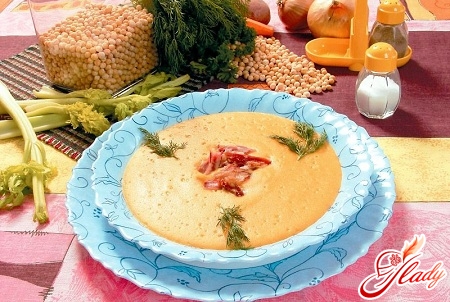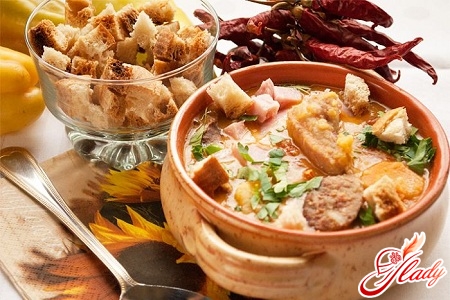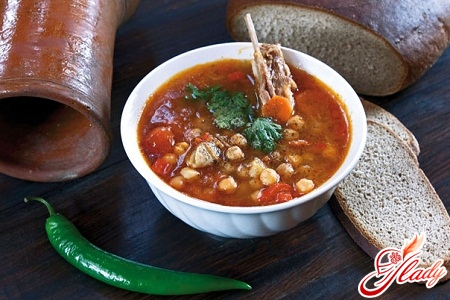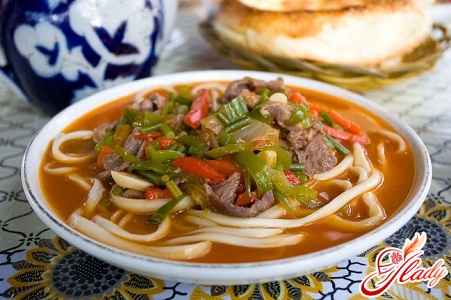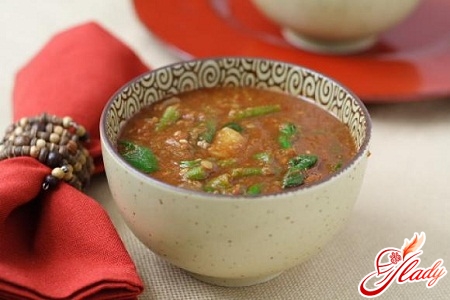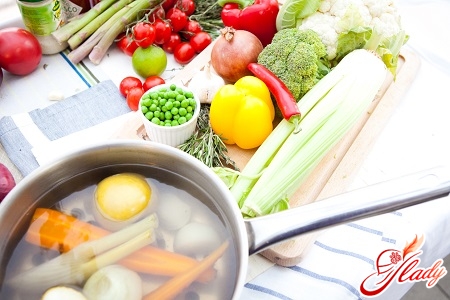
Every time I think about whatto cook for lunch, we go through a huge number of recipes for all sorts of dishes. And if you or someone else in your family also has problems with digestion, then most of the recipes are either discarded or remade at the discretion of the hostess. The most common lunch dish in our country is soup. We ate it in kindergartens, it is prepared in the extended group at school, and at home you can’t avoid lunch, in the menu of which one or another type of soup is always in first place. Among them, we can highlight such varieties as meat soup, vegetable soup, mushroom, fish, seafood and even fruit. This classification is given in accordance with the main component included in the recipe for the dish. However, it is quite difficult to classify them, since it is very problematic to isolate the main component. In order for the soup to be correct and tasty, it is necessary to follow the main rules when preparing it, namely, that the liquid in it should not be more than 50% of the total mass of the prepared dish. Although much depends on your requirements, tastes and stomach capabilities.
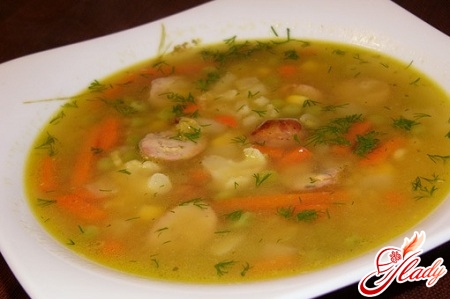
Features of vegetable soups
There are no vegetable soups in our country or in any other country.another country cannot do without it, if only because several times a year Orthodox Christians, observing Lent, refuse to eat meat. Another factor influencing the spread of vegetable soups in Russia is that agricultural activity is still more developed among the population here. It is due to this that Russian citizens prefer a recipe that requires cooking home-grown products. Well, the issue of vegetarianism also contributes to the development of this category of soups. But, nevertheless, one should not forget that vegetable soup can be cooked in meat broth and even with the addition of meat, and the main component of such a dish will still be a vegetable that will need to be cooked in meat broth. Thus, soups, the main element of which are such traditional vegetables for central Russia as potatoes, cabbage, carrots and onions, are an excellent basis for soup with beef or pork. For legumes, lard or smoked meats will be a good combination. Well, for soups containing greens (sorrel, nettle), dietary broths with rabbit and poultry meat are needed. Additional ingredients in the soup recipe include cereals, pasta, crackers, eggs, dumplings and much more. Cream, all kinds of sauces, cheeses, sour cream, olive oil are used to season the soup. One should not lose sight of such a factor as decorating the dish, which is rarely included in the recipe. For this purpose, sprigs of greens, fancy-cut tomatoes, lemon wedges, olive halves or chopped nuts and seeds are used. Pies, croutons, toasts are often prepared as accompanying products. So, there are more than 200 varieties of vegetable soups in the world. And this is only the officially registered data. If you add to them every recipe that housewives use, you will get a very large list.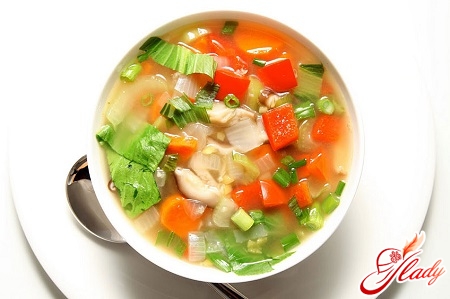
Vegetable soup and cooking features
To prepare this soup,First of all, you need broth. It can be cooked both on the vegetables themselves and on some other products. As with any dish, you need to use only fresh products, which must be thoroughly washed and peeled. Since all vegetables have different compositions and, accordingly, react differently to heat treatment, then when cooking them, you need to take into account the cooking time of each vegetable. Otherwise, it may turn out that the potatoes are undercooked, and the cabbage, on the contrary, is overcooked. Despite the fact that the soup may have the same name, it can be cooked differently in different countries.
The main varieties of vegetable soups
By the main component used inWhen preparing a particular dish, you can distinguish not only the varieties of soups, but also their subspecies. They depend on what taste features are decisive. Borscht - vegetable soup with beetroot flavor Many may resist such a definition of borscht, but borscht belongs to the category of vegetable soups. After all, the main vegetable that determines the taste here is beetroot. History of the origin and etymology of borscht Several factors influenced the name of this dish. The most basic is what it consists of. According to some sources, in ancient times, the main component of this dish was hogweed. However, you should not confuse that hogweed with Sosnowski's hogweed, which causes burns. This hogweed, the leaves of which were eaten, was added to soups that were called borscht. According to other sources, the word "bársch" was previously called beetroot, but there is no data on this in any etymological dictionary. But in some Slavic dialects there are colloquial names for beets - buryak. There is no data on the origin of borscht. But according to some data, this dish appeared on the territory of Kievan Rus. That is why it was most widespread and diverse in this region. Borscht has been mentioned in Russian documents since the 16th century, and, according to some data, borscht was the favorite dish of Catherine II, Alexander II. Borscht cooking technology This soup is a rather complex multi-component dish. When preparing it, you should be very careful about all its stages. Properly prepared vegetable soup is very tasty, beautiful and satisfying. The main component of this soup is beets. It is they that can give the dish a special color, taste and aroma. The difficulties in preparing borscht are mainly associated with beets. Before putting the beets in the soup, they must be properly prepared. First, they should be washed and cut into small pieces (some grate them on a coarse grater). The chopped vegetable is stewed in a frying pan, and in addition to oil, you should add acid to it (this can be vinegar or citric acid, lemon juice), which will prevent the beets from discoloring during cooking. All other vegetables are fried separately - onions, carrots, herbs. Almost at the very end, tomato paste or fresh tomatoes, cut into small slices, are added to them, which should be cooked for no longer than 5 minutes. This is a kind of soup dressing. The question remains open about what kind of broth to use for such a "beautiful" dish. First of all, nutritionists and chefs advise focusing on your own taste. So, you can use vegetable broth, in which you need to boil carrots, onions and other vegetables before frying. At the same time, you must follow the main rule - in order for the finished soup to be as rich as possible, you need as many vegetables as possible, because no plant can compare in the effect of satiety with meat. In different regions, however, not only regular water is used as broth, but also kvass with the addition of meat. And even fermented milk products can be added to vegetable soup.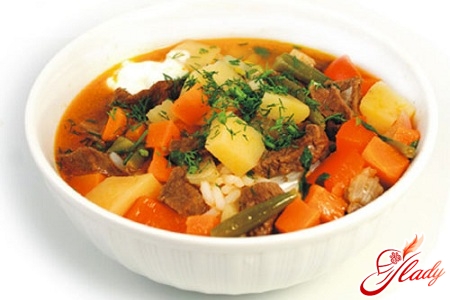 Rassolnik as a main dish of Russian cuisine HowIt is not surprising, but the recipe for rassolnik is unique. This is, first of all, in the simplicity of its preparation, in the absence of the need to involve a large number of ingredients, and also in the fact that it has several varieties depending on the "target" audience of the dish. The main element of rassolnik in any of its forms is still a pickled cucumber. And depending on the additional products, rassolnik can be traditional and vegetarian. The first option involves rassolnik with meat, which is usually the so-called "offal", for example, pork, beef or chicken liver. You can add meat and many other vegetables, cereals, seasonings, and even greens to it. Despite the fact that the recipe for rassolnik includes pickles, it should not be too spicy and oversalted. So when preparing the soup, it is better not to add salt at all, and during the meal, everyone will salt it or add some other spices to their taste. Recipe and technology for making rassolnik It is not very difficult to prepare such a vegetable soup as rassolnik. To get a tasty lunch, you need to add the following ingredients to it:
Rassolnik as a main dish of Russian cuisine HowIt is not surprising, but the recipe for rassolnik is unique. This is, first of all, in the simplicity of its preparation, in the absence of the need to involve a large number of ingredients, and also in the fact that it has several varieties depending on the "target" audience of the dish. The main element of rassolnik in any of its forms is still a pickled cucumber. And depending on the additional products, rassolnik can be traditional and vegetarian. The first option involves rassolnik with meat, which is usually the so-called "offal", for example, pork, beef or chicken liver. You can add meat and many other vegetables, cereals, seasonings, and even greens to it. Despite the fact that the recipe for rassolnik includes pickles, it should not be too spicy and oversalted. So when preparing the soup, it is better not to add salt at all, and during the meal, everyone will salt it or add some other spices to their taste. Recipe and technology for making rassolnik It is not very difficult to prepare such a vegetable soup as rassolnik. To get a tasty lunch, you need to add the following ingredients to it:
- carrot,
- bow,
- potatoes,
- cabbage,
- greenery,
- cucumbers,
- cucumber pickle,
- vegetable oil,
- seasonings to taste.
To make this vegetable soup,First, you need to prepare the broth. To do this, boil 2-2.5 liters of water in a saucepan, peel the pickles and throw them into the boiling water. This will be the basis for the rassolnik broth. After you wash all the vegetables and greens, you need to chop them and cook them. First of all, take the greens and onions. Chop them into strips and fry in oil. So, we have a large saucepan and a frying pan on the stove. We will need another small saucepan (or ladle). Pour half a glass of broth into it and put the chopped pickles in it. Reduce the boiling water to a minimum and, covering the saucepan with a lid, leave it to simmer until the cucumbers soften. At the same time, while the broth and cucumbers are cooking and the onions and greens are frying, we cut the potatoes into small cubes and shred the cabbage. The sautéed vegetables can be turned off immediately as soon as they acquire a pleasant golden color. First, add the potatoes to the broth, and a little later the cabbage. After boiling them for about 15-20 minutes, add the fried vegetables and stewed cucumbers. About 5 minutes before the end of cooking, add salt, pepper and any other spices to the soup. 1 minute before the end of cooking, you need to pour the cucumber brine into the rassolnik. So, the delicious soup is ready. In addition to this recipe, there are other varieties. For example, you can cook rassolnik with mushrooms, with millet, oatmeal or with other cereals. This option is traditional, vegetarian. Another way to cook rassolnik is a recipe containing meat. For example, the recipe for "Leningrad rassolnik" is based on meat broth. In this case, the meat that we will cook should be boneless. We take it out after it is cooked. It is necessary to cook the cereal in advance, this will take about half an hour. All vegetables are used and prepared in the same way as in the traditional version, but here the cereal is first put into the broth, and after half an hour you can start with the vegetables (in the same order - potatoes, cabbage, fried onions and greens). This delicious rassolnik is served with meat, which can be put in pieces directly into a plate with soup, or can be laid out on a dish from which it can be easily taken out by everyone and added to the soup.




